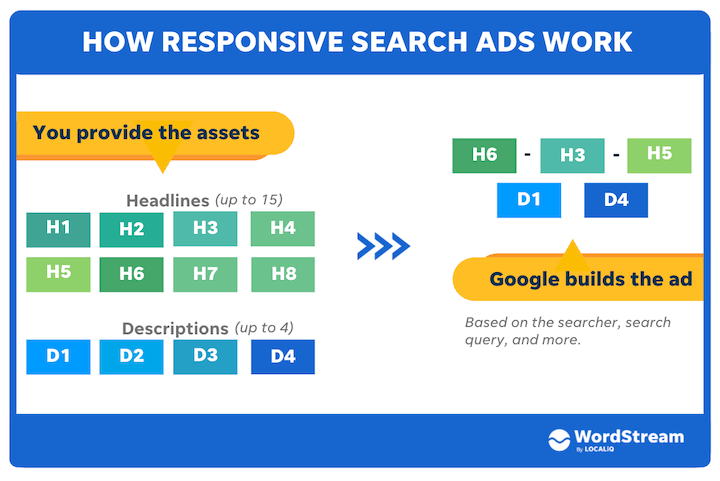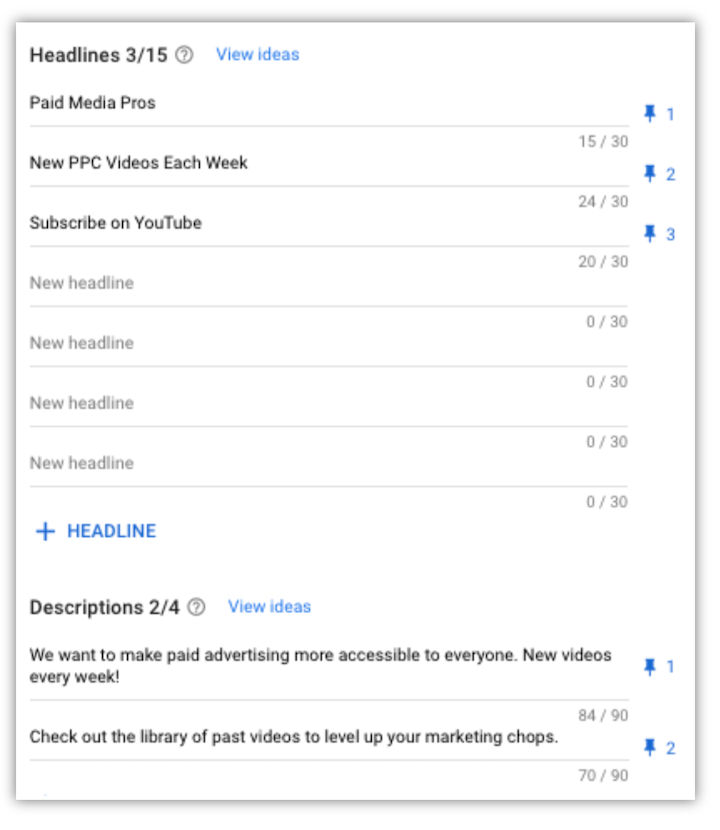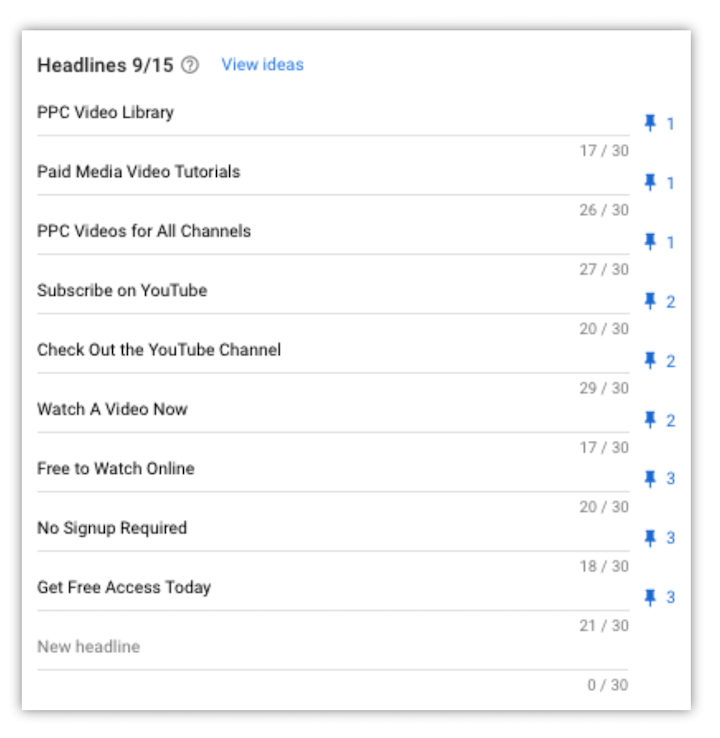ICYMI, responsive search ads (RSAs) are soon to be the only standard Search campaign type in Google Ads. With this ad format, you provide up to 15 headlines and four descriptions and Google will mix and match those into ads that best fit each search.

But you’re not just dealing with 15 headlines and four descriptions. You’re dealing with combinations and permutations that all need to make sense. This is enough to make anyone’s brain hurt. But today, I’m going to share with you a simple process for writing responsive search ad headlines (and descriptions, for that matter)—with a template to make your life even easier.
Responsive search ad copy strategies
Before we get into the process, it might be helpful to understand where you (or your PPC partner) falls on the RSA copywriting spectrum. You’ll probably be able to tell pretty quickly the one that I think you should adopt.
The Control Freak
Pins precisely three headlines and two descriptions
The Control Freak is extremely averse to letting Google make any decisions for them whatsoever. To them, the transition from expanded text ads (ETAs) to RSAs is almost an existential threat, so they’ll do everything they can to regain that control.
In particular, they’ll simulate an ETA with their RSA by providing only three headlines and only two descriptions and pinning them all. If you do that, your ad will look similar to the one below.

- Pros: For highly regulated industries prone to Google Ads disapprovals, think financial or health care, controlling all messaging could be the only path forward to ensure you’re legally covered. Whether it’s anti-discrimination, legal disclaimers, or something else, if you have ad messaging that must be included, you may need to forgo any automation and ensure you’re presenting your company or client in a compliant manner.
- Cons: If you do use this full control approach, you could open yourself up to lower ad strength scores which, while we’re told they don’t currently impact ad rank, could have some negative impacts. Additionally, you’ll be missing out on the potential upside that machine learning could bring to your account.
The Hot Mess
Throws RSA spaghetti at the wall…blindfolded
Unlike the Control Freak, the Hot Mess has absolutely no strategy whatsoever when writing their Google ads. This person adds a new variant, chucks in a number of headlines and a few descriptions based on their whims of the moment, hits publish, and then probably drunk texts an ex while jaywalking under a ladder and carrying a black cat.
They also likely have far too many or far too few ads in each ad group (terrible account structure) and aren’t taking advantage of the insights their ad performance is giving them.
- Pros: None.
- Cons: Too many to list
None of this is a good look.
The Calculated Practitioner
Is both pro-pin and pro-automation
Rather than controlling every single aspect of the ad copy or letting the phases of the moon decide your performance, the Calculated Practitioner has a strategy in place to both ensure their ads will be congruent from start to finish as well as take advantage of machine learning to see improved performance.
- Pros: This strategy allows you to write super-effective Google Ads that follow RSA best practices (see the cheat sheet below).
- Cons: For the Hot Mess, this means more work. For the Control Freak, it means giving up some control.
So what is the strategy of the Calculated Practitioner? We’ll get to that shortly.
Responsive search ad copy best practices
To fully understand this strategy, you’ll want to make sure you know RSA best practices. You can find them all in this responsive search ad 101 post, but here are the basics:
- Don’t use the bare minimum. Use at least 8-10 of the 15 headlines, and at least three of the four descriptions available to you.
- Keep your headlines distinct. Google will not show similar variations.
- Don’t put keywords in every headline. At least three of your headlines should not be keyword-focused (i.e., shares a feature, benefit, or CTA).
- Pin sparingly. Over-restricting can limit Google’s ability to maximize your ad combinations and performance.
- Vary headline lengths. This will allow Google to show ads with two or three headlines, so don’t use all 30 characters for all headlines.

View the full cheat sheet here.
5 steps to writing great responsive search ads
Alright, now that you know the best practices and where you stand on the Hot Mess –> Control Freak spectrum, you’re ready to learn the strategy. I’ll use a fictional example of an ad for my Paid Media Pros YouTube channel.
Step #1: Create different types of headlines
Use this spreadsheet template to brainstorm headlines of varying types. In it you’ll see eight different categories of headline types, with character counters.

Get the free Google Sheet template here.
Here are the categories I’d suggest, as well as some made-up examples:
- Keyword focused: PPC Video Library, PPC Videos for All Channels, Free PPC Videos
- Features: Step-by-Step Tutorials, Learn At Your Own Pace
- Benefits: Improve Ad Performance, Grow Your Business, Save Wasted Budget
- Brand messaging: Paid Media Pros,
- Social proof: Over 17k Subscribers
- Price comparison: Free to Watch Online
- Advantage over competitor: Watch Ad-Free, No Signup Required
- Calls to action: Get Free Access Today, Check Out the YouTube Chanel, Subscribe on YouTube
Write as many headlines as you can think of that fit within those categories. If there are other categories that make sense for your specific industry, add them in there as well.
Step #2: Assemble categories into themed templates
Now that we have some headlines, we need to decide where they’re going to go. But before we choose specific headlines for each RSA, we’re going to outline a template for the RSA as a whole.
Here are a few examples you could run with—again, focusing only on headlines at the moment.
 Link to the template is above.
Link to the template is above.
Each headline matches a category that you have already written a number of headlines for, but the idea here is to map out overall message flow.
Don’t forget, headline position #3 doesn’t always show for each impression, so this portion of the messaging shouldn’t be something imperative for every impression.
Step #3: Add messaging & pin into your template
Now it’s time to put your money where your mouth is. When you create your RSA, choose the template you’re going to use and add in the headlines from each category, then pin them into the templated spot.

For this example, I used Template #1 from Step #2 to create my ad, which is:
Keyword focused – Call to action – Price comparison
Each headline that is keyword-focused is pinned into Headline position #1, calls to action are in Headline position #2, and price comparisons are pinned in Headline position #3.
As you can see above, you can pin multiple components into the same placement, but the key here is to make sure you pin appropriately.
If you pin at least one headline into all three headline placements, then leave other headlines unpinned, those unpinned headlines will not be used. So to employ this strategy appropriately, pin every headline.
Step #4: Follow a similar 3-step process for descriptions
Clearly, headlines are not the only components for RSAs. Conduct a similar practice of theme generation and content writing for descriptions and add them to your headline templates to create an entirely cohesive ad variant.
Some tips for description writing:
- Try not to duplicate the language used in headlines. This is simply not strategic.
- Don’t forget to include calls to action in some variants.
- Description 2 won’t always show, so be sure you’re writing copy that isn’t reliant on that variable to make sense.
Here are some description examples for the fictional ad we’re building:
- We want to make paid advertising more accessible to everyone. New videos every week!
- Check out the library of past videos to level up your marketing chops.
- Learn how to advertise and get empowered to move the needle for your business.
Step #5: Get to testing
With the previous four steps, you now have a fully formed responsive search ad. It has headlines and descriptions that fit an overall template to where you can control the user experience with your brand but also allow Google to choose the specific messaging based on its “intuition.”
Now it’s time for you to test, just like you would have with Expanded Text Ads. (If you think you don’t need to test your ads, read my Google Ads mistakes post and let me change your mind.) Here are some samples of tests you can run:
- Test templates against each other. What types of messages work best in which places?
- Test within templates. Create 3 different RSAs and use the strategy outlined above for all but one component. Use each RSA to test a singular aspect of that ad to see how each does.
- Test themes of messaging within the same template. Maybe you test Template 2, but you make one variant that is all risk aversion messaging while the other is positive messaging.
At this point, your ad copy test is like a choose-your-own-adventure book.
Start writing great responsive search ad copy
Even if you’re not a huge fan of responsive search ads or you’re still chapped at having your control taken away, the fact of the matter is RSAs are here to stay. I’m not a huge fan of losing control within my ad campaigns, but I’m also not so averse to automation, and I don’t think you should be either.
So, while the Control Freaks are still fuming over the upcoming changes and the Hot Messes are oblivious to what’s about to happen to them, be the Calculated Practitioner. Get your testing house in order, have a strategy to make the most of this change, and leave your competition in the dust.
The post How to Master Responsive Search Ad Copy in 5 Steps (With a Template) appeared first on WordStream.




Recent Comments